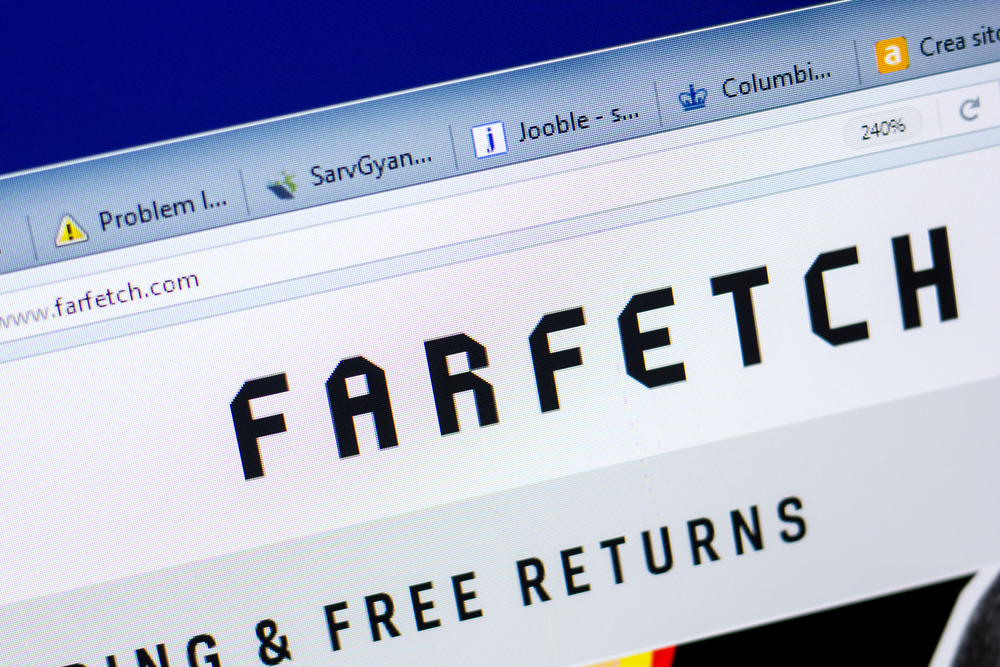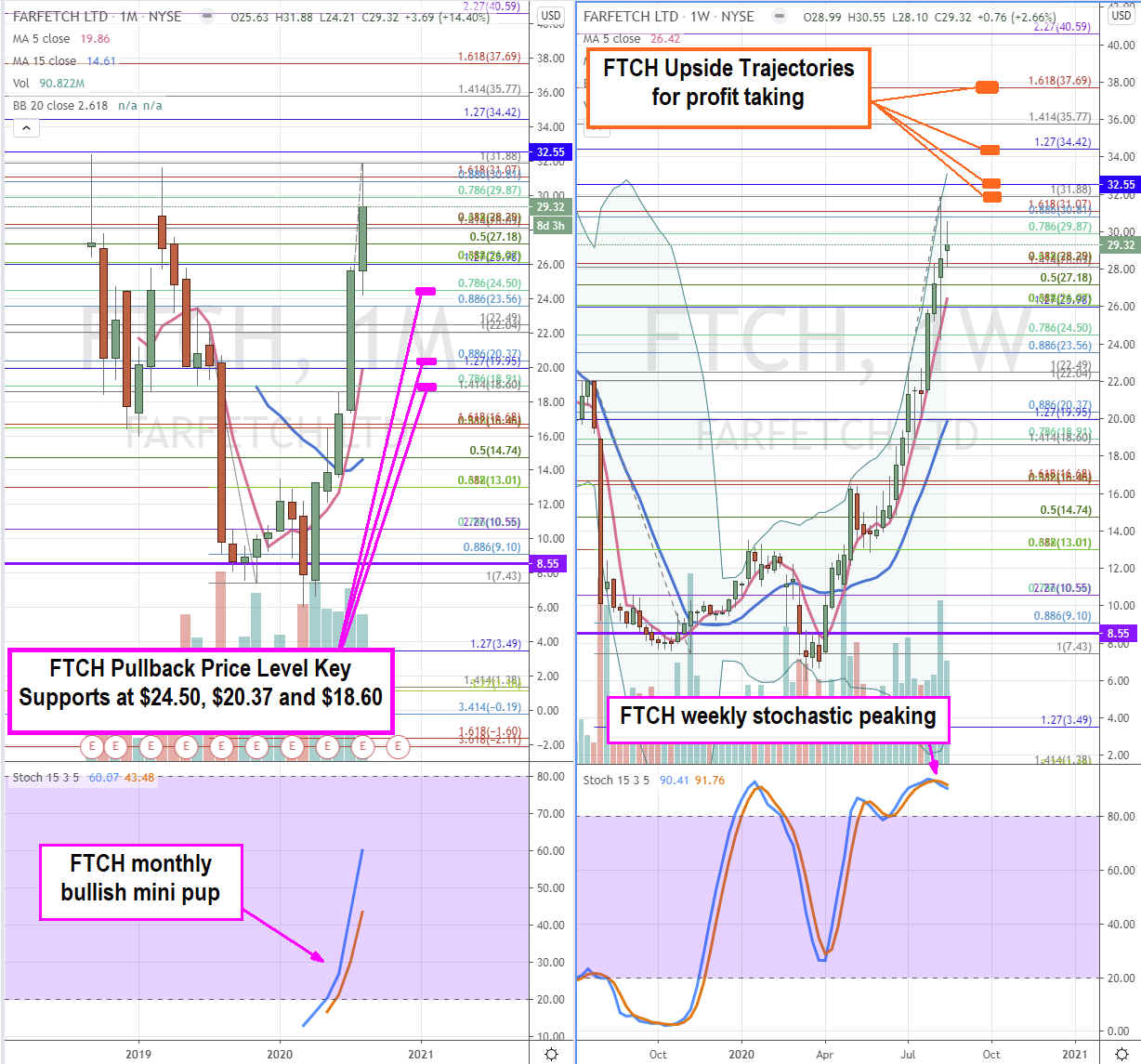
Luxury fashion and apparel auction and e-commerce platform
Farfetch NASDAQ: FTCH shares have been on a tear surging past its pre-COVID highs peaking near all-time highs. Shares collapsed on February 18
th at the start of the pandemic plunge that shaved (-34%) off the benchmark
S&P 500 index NYSEARCA: SPY before staging a rally to new highs in August 2020. E-commerce stocks have been benefactors of the pandemic as the question looms whether they can continue to accelerate as isolation restrictions are lifted and consumers return to work. Investors may consider using price trajectories to consider taking some profits off the table on FTCH stock to protect gains and reload for potential reentry at lower levels.
Q2 FY 2020 Earnings Release
On Aug. 13, 2020, Farfetch released its second-quarter fiscal 2020 earnings report for the period ended in June 2020. The Company reported a loss of (-$0.16) per share versus consensus analyst estimates for a loss of (-$0.24) per share, an $0.08 per share beat. Revenues surged 74.6% year-over-year (YoY) to $365 million, beating consensus estimates of $326.92 million. The Company saw over 500,000 new customers as a result of the pandemic. Gross Merchandise Value (GMV) grew by 48% YoY composed of 86% third-party sellers at a 29.9% take rate. Digital Platform Services revenue grew 35% YoY. First-time buyers helped drive 60% YoY traffic growth on the platform, but average order value fell by (-18%) due to a higher mix of first-time buyers. First-party margins of In-house products produced by New Guards grew to 30% versus 10% YoY due to “better full-price mix” but top-line revenues also fell (-6%) YoY.
Q3 2020 Guidance
The cash position at the end of the quarter was just over $100 million in large part due to proceeds from the $390 million convertible debt executed in April 2020. Quarterly cash burn rate has been reduced to $12 million. Convertible debt can cap stock prices as buyers can short-the-box to lock in gains on stock conversions. Farfetch raised its Q3 2020 digital platform GMV growth between 40% to 45% YoY while order contribution margin to stay between 32% to 35%. The Company expects GMV between $90 million to $95 million and adjusted EBITDA to coming in between a loss of (-$20 million) to (-$25 million) YoY. The Company feels luxury shoppers have migrated online due to travel restrictions and safety concerns and feels this secular trend can be sustained. In other words, if travel restrictions get lifted and safety concerns alleviated (vaccine), then the growth may be stifled. There in lies the uncertainty as a COVID-19 vaccine nears prompting investors to consider taking some profits.
Pandemic Driven Demand (and Competition)
Farfetch attributed the 60% traffic and over half a million new customers (of nearly 2 million total) coming on board due to effects of the pandemic. This calls into question how long can the swell last as the pandemic effects curtail and what happens when a vaccine is approved? While the Farfetch platform tries to serve as a one-stop shop for luxury brands, it has much online competition including the likes of Amazon NASDAQ: AMZN , eBay NASDAQ: EBAY , Mercari.com and RealReal NASDAQ: REAL as well as the direct-to-consumer online channels offered from the actual brands.

FTCH Price Trajectory Levels
Using the rifle charts on the monthly and weekly time frames provides a broader view of the landscape for FTCH stock. The upside trajectory price levels are ideal liquidity areas to consider taking profits off the table. The lower price trajectory levels can act as stop-loss areas for longs as well as reversion bounce levels for nimble traders. The weekly rifle chart triggered a market structure low (MSL) buy above $8.55 as the stochastic made a full 30-band to 80-band oscillation before bouncing back up through the 80-band and peaking the shares at a potential triple top around $31.40 to $32.00. Upside profit taking price levels sit at the $31.88, $32.55, $34.42 and $37.69 should the weekly stochastic continue to cross back up. On the flipside, a weekly market structure high (MSH) sell triggers under the $28.09 Fibonacci (fib) level. If the weekly stochastic falls back under the 80-band stochastic then the lower range trajectories call for tests of key support levels at $24.50 fib, $20.37 monthly 5-period moving average (MA)/fib and $18.60 double fib range. The narrative driver calls for continued travel restrictions and safety fears to keep shoppers engaged. The FDA approval of a COVID-19 vaccine can reverse the narrative and stifle growth to reverse sentiment and share prices.
Before you make your next trade, you'll want to hear this.
MarketBeat keeps track of Wall Street's top-rated and best performing research analysts and the stocks they recommend to their clients on a daily basis.
Our team has identified the five stocks that top analysts are quietly whispering to their clients to buy now before the broader market catches on... and none of the big name stocks were on the list.
They believe these five stocks are the five best companies for investors to buy now...
See The Five Stocks Here
With the proliferation of data centers and electric vehicles, the electric grid will only get more strained. Download this report to learn how energy stocks can play a role in your portfolio as the global demand for energy continues to grow.
Get This Free Report
Like this article? Share it with a colleague.
Link copied to clipboard.